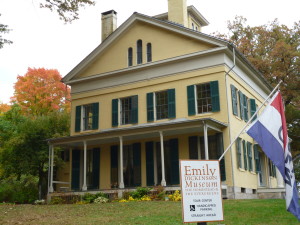My Visit to the Emily Dickinson House, and a Review
Over a year ago, reading Lives Like Loaded Guns planted the idea in my head that I would like to visit Emily Dickinson’s home in Amherst. A week and a half ago, I made that idea a reality.

It is a rare experience when one can read a book, and then visit the place where that book occurred and find it just as you imagined. But such is possible when the book you read is a biography, and people are dedicated to preserving the legacy of its subject.
Both the homestead and the Evergreens were just as I imagined them. The Evergreens was an especially interesting experience because it has not been “restored” as the homestead has, and is instead left much in its original state. Time has taken its toll with fraying wallpaper and dull paintings, making the experience of walking through it somewhat eerie, but also more authentic.

The staff is knowledgeable, friendly, and enthusiastic. I was especially impressed that they opened the doors at 10:50 am, even though the official opening time was 11.
I’m horrible at journaling my vacations, and when I did write, rather than record what I was seeing and doing, I spent a lot of time reflecting on the pull that Emily Dickinson has on me. Poetry is not my preferred genre to write or read in, and while some of Emily’s poetry resonates down to my soul, some of it does very little for me. Yet I’ve been fascinated by her since high school; for a long time, I thought it was just because the idea of becoming “reclusive” has always held a certain allure to my introverted self. Yet, as I learn more about her, I think there is something deeper to my admiration. I like that she was not famous in her lifetime, and that she wrote poems about religion but stayed home while her family went to church, and that she claimed she “could not pray,” and that she was not necessarily the shirking violet you might associate with the word “recluse.” Although a lot about her remains a mystery, I think what she has passed down to us is an example of a life lived authentically — out of the spotlight, but totally connected to the soul. And I think a quest for authenticity is one of the driving forces in my life and in my writing. I see in Emily Dickinson an example of a writer who has achieved what so many of us yearn for.
Below is my review of my reading material for the trip.
 I Told My Soul to Sing: Finding God with Emily Dickinson by Kristin LeMay
I Told My Soul to Sing: Finding God with Emily Dickinson by Kristin LeMay
My rating: 4 of 5 stars
I read this book over the course of my East Coast vacation a couple weeks ago because visiting the Emily Dickinson museum midway through the trip was to be the pinnacle of the journey, and the reason I decided on the East Coast as our vacation destination this year.
This was a good book to read in conjunction with the visit, as it kept me immersed in Emily Dickinson’s world. It’s part biography, part academic examination of Emily’s poetry, and part spiritual memoir. I liked the study of Emily Dickinson’s complicated and evolving spirituality — most of which, it must be said, was conjecture based on Kristin LeMay’s own reading of Emily’s poetry and letters. Still, she makes a compelling case for Emily’s faith life, and one to which I can relate. One thing that I think is clear, amidst the disagreement, is that Emily was not one who believed immediately, easily, or without doubt, and somehow, that makes me trust her as a spiritual guide.
The author mainly lays out her own journey of trusting Emily Dickinson as a spiritual guide, finding kinship with her in areas as diverse as mortality and doubt and the transcendence of beauty. I would have liked this book to be more deeply spiritual memoir; I wanted to know even more about the author’s own faith journey. Where the book fell most flat for me was in the academic examination of specific poems, the picking apart of various lines and words to make her case, etc. Although central to uncovering how the author got to her ideas about Emily Dickinson’s spiritual life, it just didn’t engage me as much as the personal stories about either woman’s lives did. Still, it definitely gave me a better understanding of some of the poems in this collection — most of which are fairly obscure — than I would have come to on my own.
While this was a good choice for the trip in terms of subject-matter, I could see early on that it may not have been good “travel reading” in general. Although accessible, the subjects dealt with are weighty, and it’s not the type of book in which someone can just be “swept away.” I think it might be better suited to reading slowly before bed over a month than on airplanes and train stations in a week.